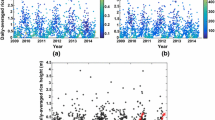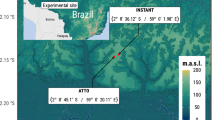Abstract
A simple aerodynamic-variance method is proposed to fill gaps in continuous CO2 flux measurements in rainy conditions, when open-path analysers do not function. The method requires turbulent conditions (friction velocity greater than 0.1 ms–1), and uses measurements of mean wind speed, and standard deviations of temperature and CO2 concentration fluctuations to complement, and at times replace, eddy-covariance measurements of friction velocity, sensible heat flux and CO2 flux. Friction velocity is estimated from the mean wind speed with a flux-gradient relationship modified for the roughness sublayer. Since normalised standard deviations do not follow Monin-Obukhov similarity theory in the roughness sublayer, a simple classification scheme according to the scalar turbulence scale was used. This scheme is shown to produce sensible heat and CO2 flux estimates that are well correlated with the measured values.
Similar content being viewed by others
References
Asanuma J, Ishikawa H, Tamagawa I, Ma Y, Hayashi T, Qi Y, Wang J (2005) Application of the band-pass covariance technique to portable flux measurements over the Tibetan Plateau. Water Resour Res 41: W09407
Baldocchi DD (2003) Assessing the eddy covariance technique for evaluating carbon dioxide exchange rates of ecosystems: past, present and future. Glob Chang Biol 9: 479–492
Brutsaert W (1992) Stability correction functions for the mean wind speed and temperature in the unstable surface layer. Geophys Res Lett 19(5): 469–472
Cellier P, Brunet Y (1992) Flux-gradient relationships above tall plant canopies. Agric For Meteorol 58: 93–117
Chen JM, Govind A, Sonnentag O, Zhang Y, Barr A, Amiro B (2006) Leaf area index measurements at fluxnet canada forest sites. Agric For Meteorol 140: 257–268
Chen B, Black TA, Coops NC, Hilker T, Trofymow JA, Morgenstern K (2008) Assessing tower flux footprint climatology and scaling between remotely sensed and eddy covariance measurements. Boundary-Layer Meteorol 130: 137–167
de Souza EB, da Rocha EJP (2006) On the diurnal variability of rainfall in eastern amazonia along atlantic coast during rainy season. In: Proceedings of 8th ICSHMO, Foz do Iguac̨u, 24–28 April 2006, pp 1203–1207
Dias NL, Brutsaert W (1996) Similarity of scalars under stable conditions. Boundary-Layer Meteorol 80: 355–373
Dias NL, Duarte HF, Maggiotto SR, Grodzki L (2007) An attenuated eddy covariance method for latent heat flux measurements. Water Resour Res 43: W04415
Falge E, Baldocchi D, Olson R, Anthoni P, Aubinet M, Bernhofer C, Burba G, Ceulemans R, Clement R, Dolman H, Granier A, Gross P, Grünwald T, Hollinger D, Jensen N-O, Katul G, Keronen P, Kowalski A, Lai CT, Law BE, Meyers T, Moncrieff J, Moors E, Munger JW, Pilegaard K, Rannik Ü, Rebmann C, Suyker A, Tenhunen J, Tu K, Verma S, Vesala T, Wilson K, Wofsy S (2001) Gap filling strategies for long term energy flux data sets. Agric For Meteorol 107: 71–77
Garratt JR (1980) Surface influence upon vertical profiles in the atmospheric near-surface layer. Q J Roy Meteorol Soc 106: 803–819
Garratt JR (1983) Surface influence upon vertical profiles in the nocturnal boundary layer. Boundary-Layer Meteorol 26: 69–80
Garratt J (1994) The atmospheric boundary layer. Cambridge University Press, UK, p 316
Harman IN, Finnigan JJ (2007) A simple unified theory for flow in the canopy and roughness sublayer. Boundary-Layer Meteorol 123: 339–363
Hill RJ (1989) Implications of Monin-Obukhov similarity theory for scalar quantities. J Atmos Sci 46: 2236–2244
Horst TW (1997) A simple formula for attenuation of eddy fluxes measured with first-order response scalar sensors. Boundary-Layer Meteorol 82: 219–233
Humphreys ER, Black TA, Morgenstern K, Li Z, Nesic Z (2005) Net ecosystem production of a douglas-fir stand for 3 years following clearcut harvesting. Glob Chang Biol 11: 450–464
Humphreys ER, Black TA, Morgenstern K, Cai T, Drewitt GB, Nesic Z, Trofymowb JA (2006) Carbon dioxide fluxes in coastal douglas-fir stands at different stages of development after clearcut harvesting. Agric For Meteorol 140: 6–22
Kaimal J, Finnigan J (1994) Boundary-Layer flows. Oxford University Press, UK, p 289
Katul G, Goltz SM, Hsieh C-I, Cheng Y, Mowry F, Sigmon J (1995) Estimation of surface heat and momentum fluxes using the flux-variance method above uniform and non-uniform terrain. Boundary-Layer Meteorol 74: 237–260
Katul G, Hsieh C-I, Bowling D, Clark K, Shurpali N, Turnipse A, Albertson J, Tu K, Hollinger D, Evans B, Offerle B, Anderson D, Ellsworth D, Vogel C, Oren R (1999) Spatial variability of turbulent fluxes in the roughness sublayer of an even-aged pine forest. Boundary-Layer Meteorol 93: 1–28
Lee X, Wu H, Sigler J, Oishi C, Siccama T (2004) Rapid and transient response of soil respiration to rain. Glob Chang Biol 10(6): 1017–1026
Mölder M, Grelle A, Lindroth A, Halldin S (1999) Flux-profile relationships over a boreal forest—roughness sublayer corrections. Agric For Meteorol 98(99): 645–658
Moore CJ (1986) Frequency response corrections for eddy correlation systems. Boundary-Layer Meteorol 37: 17–35
Morgenstern K, Black TA, Humphreys ER, Griffis TJ, Drewitt GB, Cai T, Nesic Z, Spittlehouse DL, Livingston NJ (2004) Sensitivity and uncertainty of the carbon balance of a pacific northwest douglas-fir forest during an el niño/la niña cycle. Agric For Meteorol 123: 201–219
Padro J (1993) An investigation of flux-variance methods and universal functions applied to three land-use types in unstable conditions. Boundary-Layer Meteorol 66: 413–425
Sun Y, Solomon S, Dai A, Portman RW (2006) How often does it rain. J Clim 19(6): 916–934
Tillman JE (1972) The indirect determination of stability, heat and momentum fluxes in the atmospheric boundary layer from simple scalar variables during dry unstable conditions. J Appl Meteorol 11: 783–792
Williams CA, Scanlon TM, Albertson JD (2007) Influence of surface heterogeneity on scalar dissimilarity in the roughness sublayer. Boundary-Layer Meteorol 122: 149–165
Wyngaard JC, Coté OR, Izumi Y (1971) Local free convection, similarity, and the budgets of shear stress and heat flux. J Atmos Sci 28: 1171–1182
Xu L, Baldocchi D, Tang J (2004) How soil moisture, rain pulses, and growth alter the response of ecosystem respiration to temperature. Glob Biogeochem Cycles 18: GB4002
Author information
Authors and Affiliations
Corresponding author
Rights and permissions
About this article
Cite this article
Dias, N.L., Hong, J., Leclerc, M.Y. et al. A Simple Method of Estimating Scalar Fluxes Over Forests. Boundary-Layer Meteorol 132, 401–414 (2009). https://doi.org/10.1007/s10546-009-9408-0
Received:
Accepted:
Published:
Issue Date:
DOI: https://doi.org/10.1007/s10546-009-9408-0




